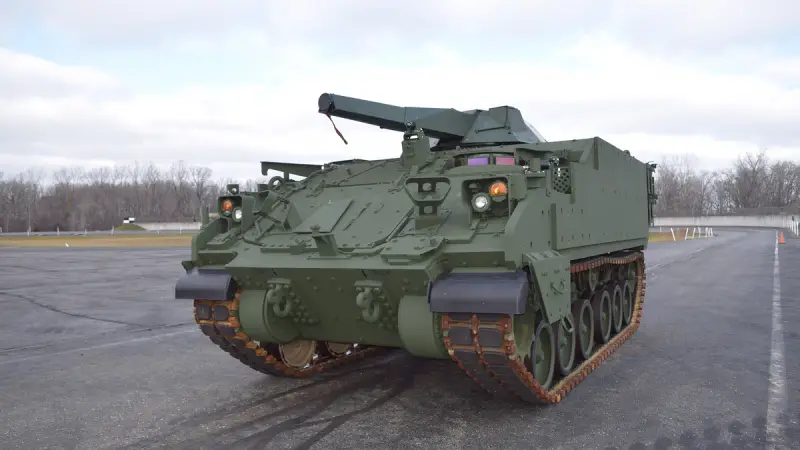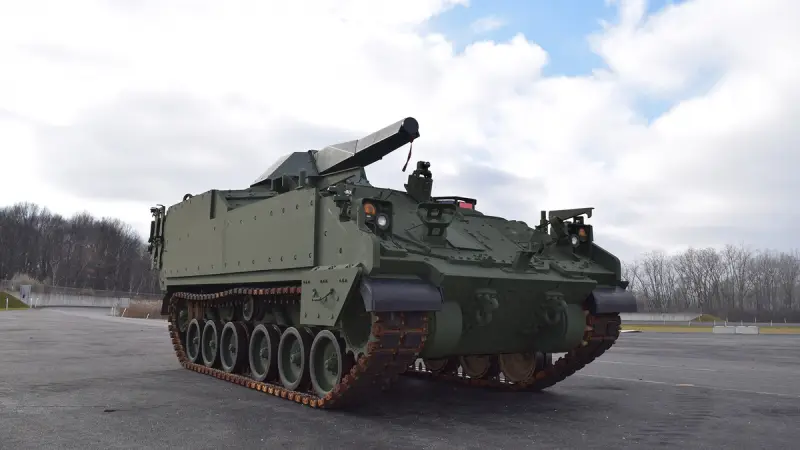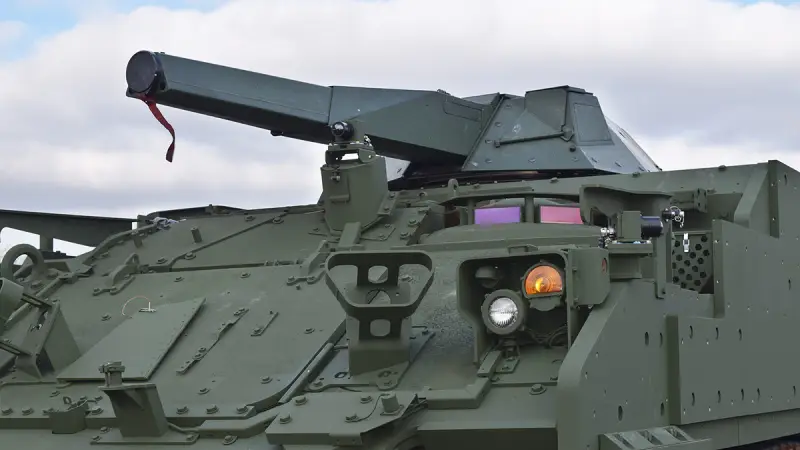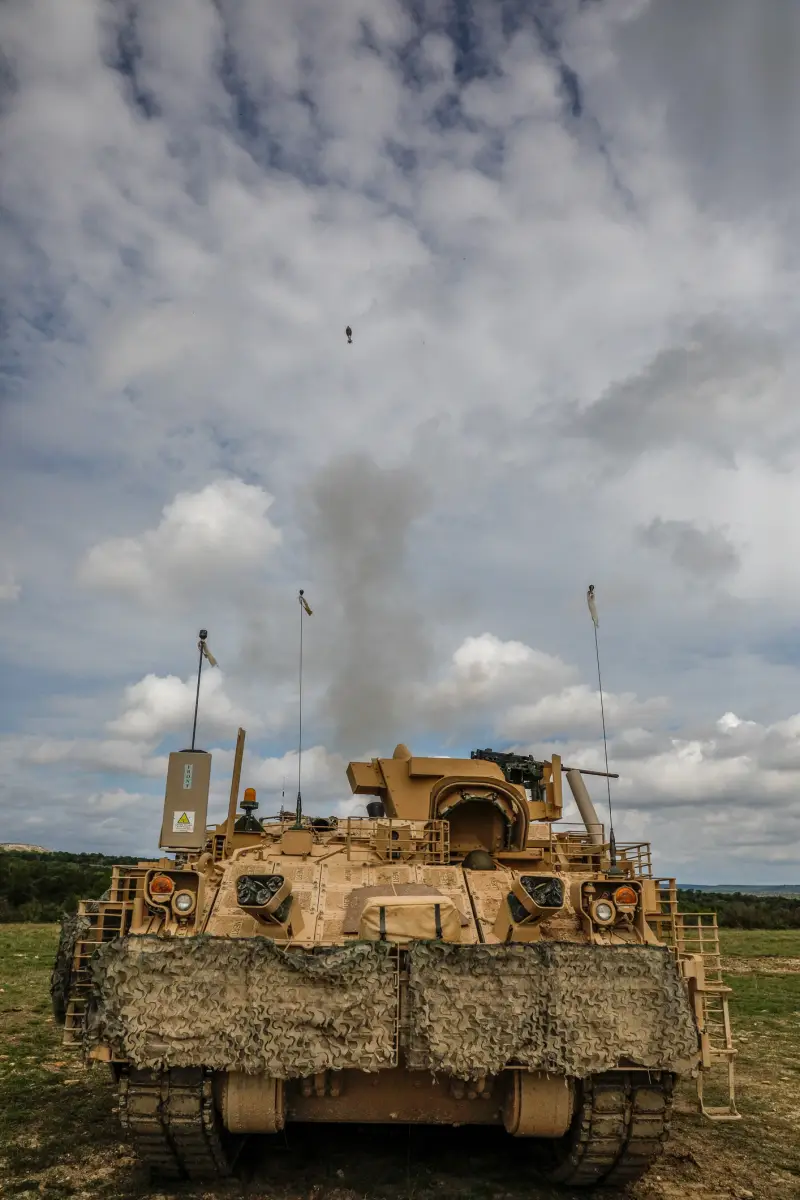BAE Systems presented the NEMO self-propelled mortar on the AMPV chassis

Experienced self-propelled mortar AMPV NEMO
Since last year, BAE Systems has been conducting full-scale mass production of armored vehicles of the AMPV family for the US ground forces. In parallel with this, issues of further development of the line through certain samples are being worked out. Thus, recently an experimental self-propelled mortar was built on the basis of an existing chassis, equipped with a Finnish-designed NEMO fighting compartment. In the near future, this machine will go to the test site and demonstrate its potential.
New concepts
The Pentagon AMPV (Armored Multi-Purpose Vehicle) program started in 2013; its goal was to create a new line of armored vehicles to replace the old M113 armored personnel carrier and its derivatives. One of the program participants was BAE Systems. Already at the end of 2014, she was announced as the winner of the competition. Two years later, it presented the first prototypes, then tested them, and in 2020 began mass production “at a low rate.” A full-fledged series started in the summer of 2023. By this time, the first batches of armored vehicles entered the troops.
While establishing mass production, BAE Systems did not forget about the further development of the project. So, in 2022, the Pentagon was presented with an option to modernize the AMPV platform under the designation ExMEP (External Mission Equipment Package). It provided for modification of the upper part of the hull and some internal equipment of the armored vehicle for compatibility with a wide range of combat modules with one or another weapon.
Also in 2022, the development company and the army discussed the prospects of the ExMEP project and decided to test its real potential using full-fledged experimental equipment. The development of two new modifications of the AMPV has begun - an anti-aircraft missile and gun system and a self-propelled mortar with an automated combat module.
To date, BAE Systems has completed the development of both experimental projects and presented prototypes. Thus, the air defense missile system under the designation AMPV C-UAS was presented at the end of January 2024, and by this time the prototype of the vehicle had already been tested.

At the same time, a self-propelled mortar was created on a standardized chassis. They decided to arm it with a NEMO turret, for which the Finnish company Patria and the Norwegian Kongsberg were involved in the project. Development did not take much time, and by now BAE Systems had managed to build an experimental armored vehicle. Its readiness was announced on March 6, 2024.
The self-propelled mortar and air defense missile system will soon be transferred to the Pentagon for evaluation tests. The military will check the operation of various systems and draw conclusions about both the combat vehicles and the ExMEP modernization package. It cannot be ruled out that successful completion of the tests will allow two new vehicles to go into production and enter service with the troops. However, the likelihood of such a development is unknown.
Technical features
The self-propelled mortar prototype shown is a tracked armored vehicle based on an existing platform, equipped with a Patria NEMO fighting compartment. This model retains the driving characteristics and protection parameters at the level of any other vehicle in the AMPV family, but receives new fire capabilities.
The AMPV platform is generally based on the design of the production M2 Bradley infantry fighting vehicle. The same layout and technical solutions are used, and a number of basic units are retained. At the same time, the design of the original machine was modified and improved taking into account the accumulated operating experience. Thus, due to the overhead modules, ballistic and mine protection is enhanced. A new power plant was used to compensate for the increase in mass, etc.
The housing for the self-propelled mortar has been modernized according to the ExMEP project. It features a redesigned upper for increased strength and rigidity. Such a hull can carry large and heavy combat modules, as well as withstand the recoil impulse of their weapons. In addition, the body of the ExMEP version has other minor differences and improvements.

Turret and driver's hatch close-up
The reinforced hull is equipped with a Finnish-made NEMO (New Mortar) fighting compartment. This is an automated turret with a total weight of 1,9 tons with a 120 mm smoothbore mortar, an automatic loader and mechanized stowage. A combat module control panel is mounted inside the vehicle body; all basic operations are carried out automatically according to operator commands.
The NEMO turret carries a 120 mm caliber breech-loading smoothbore mortar mounted on hydropneumatic recoil devices. The rotation of the turret provides circular horizontal guidance, and the swinging part provides vertical guidance angles from -3° to +85°. The maximum rate of fire reaches 10 rounds/min; stable during long-term shooting - 6 rounds/min. Standard 120 mm mines of various types are used.
The standard fire control system for NEMO determines the coordinates of the firing position and calculates firing data with high accuracy, and also controls the process of aiming, supplying ammunition and firing. There are single-fire and “barrage” modes, in which up to five mines fall on the target at the same time. The firing range depends on the type of ammunition used and can reach 8-10 km.
To increase efficiency
It should be recalled that the AMPV family of armored vehicles already has a self-propelled mortar. The product, designated M1287 MCV, has successfully passed tests, is being mass-produced and delivered to the customer. Current plans include the delivery of 387 such machines.
However, the Pentagon and BAE Systems decided to continue the development of this area and developed another self-propelled mortar. The emergence of a new experimental project can be explained quite simply - the customer and the contractor have the opportunity to make a more advanced combat vehicle with a number of advantages over the existing one.
The M1287 armored vehicle is distinguished by a certain simplicity. On it, the mortar is installed inside the hull, serviced manually and fired through a hatch in the roof. With all the advantages, such a complex has some disadvantages and limitations. In particular, its performance and operating speed depend on the skills and condition of the crew, which is why they may change as combat work continues.

M1287 MCV self-propelled mortar
The new prototype AMPV NEMO uses an automated fighting compartment that requires minimal human intervention. All main operations are carried out by mechanisms, and the load on the crew is minimal. At the same time, electronics and automation make it possible to obtain maximum firing characteristics, depending on the ammunition used.
An important advantage of the new self-propelled mortar is the use of ready-made components. Thus, the AMPV chassis is already in mass production, and its modification according to the ExMEP project is not particularly difficult. NEMO's fighting compartment is also sufficiently mature and accessible. At the same time, the new combat vehicle can use a wide range of ammunition already in service with the United States and NATO countries.
However, not only the features of the concept and its implementation matter, but also the practical result. The experienced self-propelled mortar has yet to be tested in test conditions and show its characteristics, as well as confirm the absence of serious deficiencies. Time will tell whether the AMPV NEMO prototype will be able to cope with all the tests.
Development continues
Over the past few years, BAE Systems and the US Army have developed and brought into service a whole line of new armored vehicles. Now it is mass-produced and supplied to the troops in large quantities. At the same time, it was decided to continue the development of the family. As an experiment, a modification of the original vehicle and two options for converting it into combat units for different purposes were proposed.
Two new projects have been brought to field testing, which in itself is a positive result. It is clearly shown that by slightly reworking the original design, the AMPV family can be expanded again and new models can be introduced into it. Whether the Pentagon will take advantage of such opportunities and launch additional rearmament will become clear based on the results of the tests.
Information